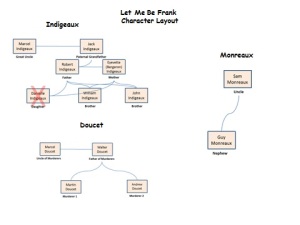As I embark on my next writing venture after a 2020 hiatus, I realized something. The equation of my age plus the stress of 2020 and the length of time since I’ve written a Frank Rozzani book has added up to me forgetting the details of many of my familiar characters. I remember reading a while back about having a character bible, a book of character profiles. The article I read talked about how this is especially important if you write a multiple-book series with the same characters.
At the time, I said to myself, “I’ll never forget these characters. They’re part of me.” Well, as I get older, I’m pretty sure there are actual parts of me that I’ve forgotten.
As I try to write for my tried and true characters, I find myself searching my previous books for things like dates, names, hair and eye color and other things that would be great to have at my fingertips. As a result, I’m revisiting the idea of the character bible. I thought that one useful resource would be to go to the blogging community of authors, editors and readers and ask for your opinions and experience.
I thought I would begin, however, by telling you what I’ve learned about this tool for those of you that haven’t heard of it or have been using elements of it without realizing it had a name.
What is a Character Bible?
There is no single definition or series of components that make up a character bible. From the research I’ve done, it’s basically a collection of character profiles each of which tell you about the character’s:
- Name – This might seem obvious, but a character’s name is important. Think of Alex Cross and the numerous James Patterson books bearing his surname in the title. To a much, much lesser degree, of course, there are my Frank Rozzani detective novels that all have ‘Frank’ in some form in the title Frankly Speaking, Let Me Be Frank, Frank Incensed (my personal favorite), Frankly My Dear and Frank Immersed.
- Physical Appearance/Mannerisms – The characters height, body type, hair color, eye color, physical anomalies and disabilities and other information about how the character looks.
- History – Information about the character’s backstory, cultural, educational and socio-economic situation and any other relevant information that is material to the plot.
- Personality – What psychological quirks, conditions or flaws does the character have? What motivates him/her? What are his/her desires? What’s missing from his/her life?
Now, the worst thing you can do is dump all of this information about the character into your story in one fell swoop. You can dribble out the information as needed in small doses. The other thing to avoid, however, is your character developing some ability or piece of knowledge from his background out of convenience to get you past a snag in the story without foreshadowing it first.
What characters should be in the Character Bible?
Again, there is no universal agreement on this, but characters you can consider are those that are pivotal to the story and more than just one-dimensional “fillers” like:
- Protagonist – The main character or hero of your story.
- Antagonist – The villain or anti-hero of your story.
- Love Interest – The person that makes your protagonist’s heart flutter.
- Sidekick – The Robin to your character’s Batman.
- Supporting Characters – Those colorful folks in the background that give humor, expertise and other key elements to your story.
- Sub-Plot Characters – The stars of those little vignettes that advance your story through the actions of secondary characters.
It’s up to you, the author, how many character profiles you put in your Character Bible. If you’re a John Grisham or James Patterson type, you probably have less than a half-dozen characters to keep straight. If you’re a Stephen King, J.K. Rowling, or J.R.R. Tolkien type writer, buy a few notebooks to fill.
Tools for Creating A Character Bible
There are several templates out there for you to create the character profiles that will become part of your character bible. I’ve selected some here to give you an idea of what’s out there:
Reedsy Character Profile
For those of you that belong to Reedsy, or even if you don’t, the site offer’s a character profile template separated into various sections. An image of the first page is shown below:

As you can see, it’s pretty straightforward and guides you through the information that makes up the profile. I see pros and cons in the level of detail. I tend to only think about what I need to know about my characters, but I suppose the additional information, much of which you’ll never use in the story, might help you get a more accurate picture of what motivates him or her.
Filestage Character Bio Template
Filestage is another online site offering a character bio template in a spreadsheet format. It does have some nuances that the Reedsy template doesn’t cover, but the spirit is the same. I suppose you can create multiple tabs to add additional characters. Here is a snapshot of what it looks like:

Internet Writing Journal
Another character profile format appears on the Internet Writing Journal site. Again, it has much of the same information and you can pick and choose how much of it you’d like to use.

Conclusion
It’s entirely up to you if you want to create a character bible. I’m headed in that direction with my latest Frank Rozzani book so I can make the current book and any additional sequels more manageable.
I’d love to hear from you on your experience with this technique. Have you used it? Have you thought about it? How do you keep your characters straight?
Your comments, as always, are welcome.






